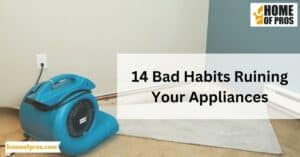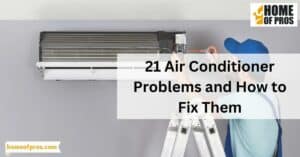Troubleshooting and repairing common issues with vacuum cleaners requires identifying problems such as loss of suction, clogged filters, or faulty motors. Cleaning or replacing filters, clearing blockages, and checking for damaged components can often resolve these issues. Regular maintenance and following manufacturer guidelines are key to keeping vacuum cleaners in optimal working condition.
In this blog post, we’ll explore common issues with vacuum cleaners and provide effective troubleshooting and repair solutions that will help you get the most out of your appliance. From clogged filters to broken belts, we’ll discuss everything you need to know to keep your vacuum cleaner running smoothly and efficiently using simple, actionable steps. So, buckle up, and let’s dive into the world of vacuum cleaner troubleshooting and repair together!

Troubleshooting and Repairing
Vacuum cleaners play an integral role in maintaining the cleanliness of our homes. However, with constant use, they can malfunction. Don’t worry, as this is where troubleshooting and repairing come in. Troubleshooting and repairing common issues with vacuum cleaners require a systematic approach that involves identifying the problem, assessing the root cause, and applying the necessary solution.
One must possess the skill set and knowledge to conduct adequate repairs and ensure that the vacuum cleaner is functional. By troubleshooting and repairing common issues, you can extend the lifespan of your vacuum cleaner and save money that you would otherwise have spent on buying a new one.
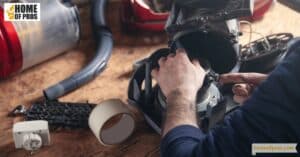
Different Types of Vacuums
Vacuums come in different shapes and sizes, and finding the right one for your cleaning needs can be overwhelming. With so many options available on the market, it’s crucial to understand the benefits and drawbacks of each type. From stick vacuums to canister vacuums, upright vacuums to robotic vacuums, there is a vast array of choices to consider.
Canister type
There are several types of vacuums available on the market today, each designed for different purposes. One specific type is the canister vacuum. Canister vacuums are known for their versatility, often featuring a long hose and wand that can easily maneuver around furniture and tight spaces. They typically have a wheeled canister that houses the motor and dust bags, allowing for easier mobility.
Canister vacuums tend to be a bit quieter than other types and are ideal for hard floors, stairs, and low-pile carpeting. If you’re looking for a vacuum that offers a lot of flexibility and suction power, a canister vacuum may be the right choice for you.

Upright models
When it comes to vacuum cleaners, there are various types available on the market, each with its unique features and benefits. One of the most popular types of vacuums is the upright model. These cleaners are versatile, boasting powerful suction capabilities and an array of useful attachments to tackle various surfaces and cleaning tasks. Upright models are particularly well-suited for cleaning larger spaces, such as living rooms and bedrooms, as they cover a more extensive area with their wide cleaning head. Their tall and slender design also means they can be stored conveniently in a closet or other tight space.

Handheld vacuums
Handheld vacuums are versatile and convenient cleaning tools for any household. Unlike other types of vacuum cleaners, handheld vacuums are compact and lightweight, making it easier to clean tight spaces or hard-to-reach areas. There are different types of handheld vacuums available on the market. Some models come with a cord while others are cordless, running on rechargeable batteries.
Handheld vacuums are also available in different types, such as upright, canister, and stick models. Upright models are perfect for deep cleaning carpets and rugs, while canister models are ideal for cleaning drapes and upholstery. Stick models are slim and lightweight, making them easy to maneuver and clean floors and carpets.

Common Problems and Solutions for Each Type of Vacuum
When it comes to cleaning your home, using a vacuum is often an essential part of the process. However, with so many different types of vacuums on the market, it can be difficult to know which one to choose. Each type of vacuum comes with its own set of common problems, but fortunately, there are also solutions for each of these issues. From bagged to bagless, canister to upright, and stick to robotic, we’ll explore the common problems and effective solutions for each type so that you can keep your home spotless without any hassle.
Canister Vacuums
- Clogged filters – Clogged filters are a common issue with canister vacuums. While canister vacuums excel in cleaning hard floors, they often struggle to maintain suction power due to blockages in the filters. To prevent this issue, it’s important to clean or replace filters regularly. In addition, regularly checking for obstructions in the hose and nozzle can help ensure optimal vacuum performance.
- Blocked hose and beater bar – Blocked hoses and beater bars can be frustrating problems for canister vacuums. Such issues can cause the vacuum to lose suction power, leaving dirt and debris on your floors. Luckily, there are solutions to get your canister vacuum back in working order. To fix blocked hoses, start by unplugging the vacuum and removing the hose. Then, use a long object such as a broom handle to dislodge any debris. For beater bars, check for any tangles or knots in the bar and carefully remove them with scissors.
- Suction problems – One of the most common problems encountered when using canister vacuums is suction issues. This problem can make it difficult to effectively clean carpets, upholstery, and other surfaces. There are several potential causes for suction problems, from blockages in the hose or brush to clogged filters or worn-out belts. Depending on the type of canister vacuum being used, there are different solutions to remedy suction issues.
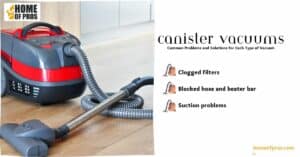
Upright Vacuums
- Motor issues – Motor issues are a common problem faced by users of upright vacuums. However, the good news is that each type of vacuum has a specific set of solutions to address these problems. Those with belt-driven motors might need to adjust their belts or replace them entirely, while those with direct air motors may require cleaning of the motor fan blades or replacing the entire motor. Brush roll motors, meanwhile, can be fixed by either unclogging them or cleaning out the bearings.
- Poor suction power – This common problem can have a variety of causes, such as a clogged filter, a full dustbin, or a damaged hose. Thankfully, there are solutions available to restore your vacuum’s suction power. Start by checking and cleaning the filter and dustbin, and if necessary, remove and replace any damaged hoses. With these simple steps, your upright vacuum will be working like new in no time.
- Belt slipping/replacement – One of the most common problems experienced by upright vacuum users is belt slipping. If your vacuum’s brush roll stops spinning or spins intermittently, it may be a sign that the belt needs to be replaced. Fortunately, replacing the belt is a relatively simple process that can be done at home with basic tools. First, unplug the vacuum and remove the bottom cover to access the brush roll and belt. Check the belt for signs of wear or damage and replace it if necessary.
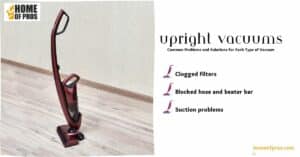
Handheld Vacuums
- Clogged filters – Clogged filters are a common problem among handheld vacuums. They can cause a decrease in suction power, making it harder to clean floors, carpets, and other surfaces. To address this issue, it is important to regularly clean or replace the filter according to the manufacturer’s instructions. Failure to do so can result in damage to the vacuum and reduce its lifespan. If you notice that the filter is frequently clogging, it may be an indication that the vacuum is not suitable for the type of debris you are cleaning up.
- Poor suction power – One issue commonly faced by handheld vacuum users is poor suction power. This can be frustrating, especially when trying to clean surfaces thoroughly. Luckily, there are solutions to this problem. First, check for clogs or blockages in the vacuum’s nozzle or filter. This can often be the cause of reduced suction power. Additionally, make sure the vacuum’s battery is charged fully to ensure maximum power. Finally, consider upgrading to a vacuum with stronger suction capabilities.
- Motor issues – Handheld vacuums can be a real lifesaver when it comes to cleaning up small messes. However, like any machine, they can encounter motor issues. Some common problems include weak suction, overheating, or a motor that won’t turn on at all. The solutions to these problems vary based on the type of vacuum you have. For a corded vacuum, check the power cord and ensure it’s plugged in properly. If it’s a cordless vacuum, make sure the battery is charged. Cleaning the filter can also help with weak suction and overheating.
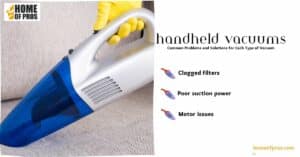
In Conclusion
Troubleshooting and repairing common issues with vacuum cleaners is an essential skill that every homeowner should possess. From clogged hoses to broken belts, there are numerous common issues that can hinder the efficiency of a vacuum cleaner. By being proactive and conducting regular maintenance and cleaning, you can prevent these issues from occurring and prolong the lifespan of your machine.
However, if you do encounter any problems, it is important to know how to identify and fix them to ensure that your vacuum cleaner continues to perform optimally. Armed with the knowledge and techniques outlined in this guide, you can confidently troubleshoot and repair common issues with your vacuum cleaner like a pro.







